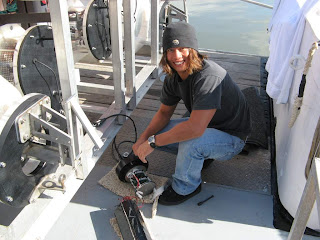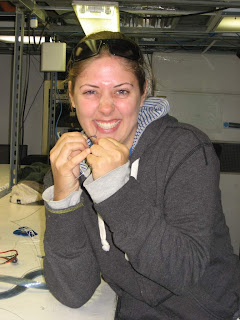
Dr. Jeff Drazen is the Chief Scientist of this research cruise. He has been a Professor of Oceanography at University of Hawaii at Manoa for about 4 years. Dr. Drazen is originally from Olympia, Washington. He grew up loving to fish and playing in the tide pools.
He received his undergraduate degree from University of San Diego in Biology and Marine Science. He then continued his education at Scripps Institution of Oceanography in Feeding Ecology of Rat Tail for his PhD.
As an undergraduate, he fell in love with the deep sea. Some of his professors brought in samples of creatures that live on or around hydrothermal vents. These vents can expel extremely hot water and also black smoke. Many interesting creatures live on or around these vents. The professor brought in samples of clams, tubeworms, and hairy snails.
Another one of his professors did deep sea trawls like the ones we are currently doing on this research cruise. He helped his professor with analyzing the fish and identifying them. Dr. Drazen saw for the first time an anglerfish and dragon fish. He was hooked on the deep sea and learning more about it.
Dr. Drazen worked on national marine vessels with assisting in their trawls. He was more interested in the ecology of the animals. The rat tail fish was the most predominant fish around the area, and Dr. Drazen was interested in what they ate and how they reproduced.
He worked at MBARI (Monterey Bay Aquarium Research Institute) for a little under 3 years. There he worked on a high pressure fish trap and on the ROV (Remote Operated Vehicle) all the way down to 4000 meters. He researched the snail fish, rat tail, and eelpouts.
He is interested in the climate change in the deep sea. By studying the metabolism of deep sea fish, it could be determined whether or not that fish will have a problem dealing with the increase of acids in the deep due to climate change. If the fish has a fast metabolism, then it will probably not be effected that much. If the fish has a slow metabolism, then there could be a problem.
Dr. Drazen is an amazing person who has accomplished a lot over the years. I am very honored to be apart of his research cruise.
John Yeh

John is the Oceanographic Instrument/Data Specialist. He received his undergraduate degree from University of California at Berkley in Chemistry. He was a chemist for a little over a year. John has always possessed a great love for the ocean. He is an avid surfer and diver. The ocean is his true passion and it brings him great happiness. This love of his led him to pursue his master’s degree in Hawaii.
He received his master’s from the University of Hawaii at Manoa in Oceanography. During his master’s program, John built a camera system for his thesis research. He has always enjoyed building things and found it very rewarding. He worked with Dr. Drazen throughout his master’s program. This time-lapse baited camera has been used to look at the scavenging communities in the main and Northwestern Hawaiian Islands. Dr. Drazen hired John to help build and assemble the respirometer when he received funding for this current research cruise.
John has also built an underwater digital recorder for a state funded project. Video data from the recorder is used to assess the effectiveness of restricted fishing areas in increasing abundance and size of commercially important bottomfish species in Hawaii.
His next adventure will a cruise to the Northwestern Hawaiian Islands this June. The objective of this research cruise is to catch animals at 3,000 to 4,000 meters observed in photographs from the time-lapse camera system for identification purposes. His next project is to build a trap to capture the scavenging animals at those depths. At least one species he hopes to capture (an eelpout observed in the time-lapse imagery) has not been documented in the islands before.
John is a key component to this research cruise. I have enjoyed assisting him and being apart of the respirometer pit crew.
Jason Friedman

Jason is in his first year as a graduate student at the University of Hawaii at Manoa in Oceanography. He received two bachelor’s degrees from Cornell University, B.S. in Evolutionary Biology and B.S. in General Oceanography.
For the last four summers, Jason has worked at Cornell's Marine Laboratory in Maine. He began as a student, and then became a Teacher's Assistant (TA). He also did work as the dive management officer. He taught a marine mammal course. They dissected three dolphins and six seals. Jason enjoyed learning about these animals.
He enjoys learning about the anatomy of fish. During this research cruise, his goal was to cross-section different fishes from different depths and different lifestyles. Jason first cuts the abdomen of the fish and then makes four slices along the tail. He tries to find the different muscles of the fish, red and white muscles. Through cross-sectioning, he can learn how fishes move under water. Cross-sectioning plus the data from the tissue samples work together to give more accurate information on the movement of fish.
The Big Island has a deep-sea pipeline that carries fish from 800 meters to the surface. Jason hopes to collect respirometry data on the fish that surface from this pipeline. Eventually he would like to be a professor at a university.
To learn more about Cornell's Marine Laboratory, please visit this site http://www.sml.cornell.edu/.
Nicole Condon

Nicole is also in her first year as a graduate student at the University of Hawaii at Manoa in Biological Oceanography. She received her undergraduate degree in Marine Biology at the University of New England in Maine. Her passion for the deep sea led her to the University of Hawaii because of their wonderful deep sea program.
She is studying metabolism and trophic ecology (food web) in sharks, skates, and rays. These are vulnerable species because they do not grow as fast as other fish species. Many times they are over fished in shallow waters. Her favorite shark is the Frill shark.
Nicole is working on her hook contraption project to collect sharks and skates here in Monterey, California. Her design is an aluminum square with many hooks around the outside. An anchor is attached with a magnesium release. Magnesium corrodes, dissolves, in water over a premeasured time. Nicole’s magnesium will corrode in about an 8 hour time period. After the magnesium corrodes, the aluminum square begins to rise to the surface.
This will be her first deployment of the hook contraption. I’m happy to help and be apart of her research project.
Michelle Kay (Me!)

Hi! I am a 6th grade science teacher at Dole Middle School in Kalihi Valley. I received my B.S. from Illinois State University in Elementary Education. I’ve lived in Hawaii for almost 9 years. My own love for the ocean and marine life brought me to the beautiful island of Oahu.
My teaching career first began teaching 5th grade at Haha’ione Elementary School in Hawaii Kai. I then taught 4th and 6th grade at Jefferson Elementary School for about 5 years. I have always enjoyed science & marine science and wanted to teach at the middle school level. I currently teach 5th and 6th grade marine science at Punahou School during the summer and 6th grade science at Dole Middle School during the school year. I have enjoyed teaching at Dole for the past two years.
My passion for marine science has led me to volunteer at Coconut Island for shark research and Dolphin Quest of Oahu to help with the education program. When I heard about Dr. Drazen’s grant proposal, I submitted my resume to be considered as the teacher to be involved with this research project.
Words cannot express how grateful I have been to be apart of this project. I have learned so much during this time, and I look forward to the second part of this research cruise this October.
Please visit my class website to see all the exciting learning that takes place!!
http://www.dolemiddle.k12.hi.us/mkay/Site/Welcome.html

“This material is based upon work supported by the National Science Foundation under Grant No. 0727135. Any opinions, findings and conclusions or recommendations expressed in this material are those of the author(s) and do not necessarily reflect the views of the National Science Foundation (NSF).”
+062.jpg)
oh wow all the ship crew are all beautiful and
ReplyDeletelooks like they are enjoying the trip
thanks for sharing the ship crew.